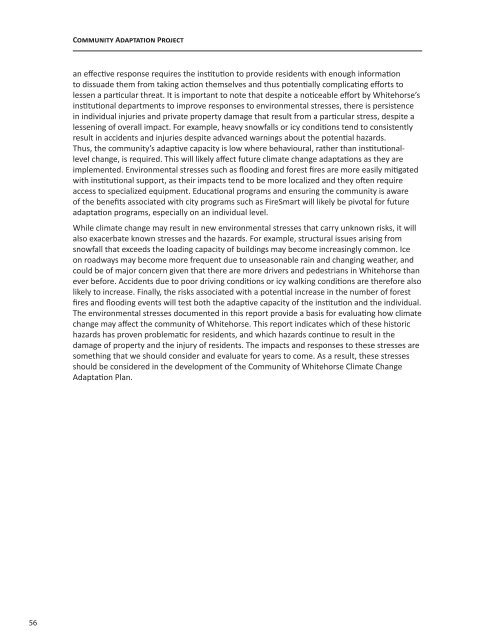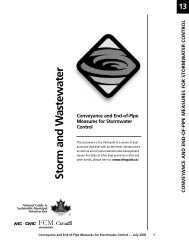Whitehorse Climate Change Adaptation Plan - Yukon College
Whitehorse Climate Change Adaptation Plan - Yukon College
Whitehorse Climate Change Adaptation Plan - Yukon College
You also want an ePaper? Increase the reach of your titles
YUMPU automatically turns print PDFs into web optimized ePapers that Google loves.
56<br />
Community <strong>Adaptation</strong> Project<br />
an effective response requires the institution to provide residents with enough information<br />
to dissuade them from taking action themselves and thus potentially complicating efforts to<br />
lessen a particular threat. It is important to note that despite a noticeable effort by <strong>Whitehorse</strong>’s<br />
institutional departments to improve responses to environmental stresses, there is persistence<br />
in individual injuries and private property damage that result from a particular stress, despite a<br />
lessening of overall impact. For example, heavy snowfalls or icy conditions tend to consistently<br />
result in accidents and injuries despite advanced warnings about the potential hazards.<br />
Thus, the community’s adaptive capacity is low where behavioural, rather than institutionallevel<br />
change, is required. This will likely affect future climate change adaptations as they are<br />
implemented. Environmental stresses such as flooding and forest fires are more easily mitigated<br />
with institutional support, as their impacts tend to be more localized and they often require<br />
access to specialized equipment. Educational programs and ensuring the community is aware<br />
of the benefits associated with city programs such as FireSmart will likely be pivotal for future<br />
adaptation programs, especially on an individual level.<br />
While climate change may result in new environmental stresses that carry unknown risks, it will<br />
also exacerbate known stresses and the hazards. For example, structural issues arising from<br />
snowfall that exceeds the loading capacity of buildings may become increasingly common. Ice<br />
on roadways may become more frequent due to unseasonable rain and changing weather, and<br />
could be of major concern given that there are more drivers and pedestrians in <strong>Whitehorse</strong> than<br />
ever before. Accidents due to poor driving conditions or icy walking conditions are therefore also<br />
likely to increase. Finally, the risks associated with a potential increase in the number of forest<br />
fires and flooding events will test both the adaptive capacity of the institution and the individual.<br />
The environmental stresses documented in this report provide a basis for evaluating how climate<br />
change may affect the community of <strong>Whitehorse</strong>. This report indicates which of these historic<br />
hazards has proven problematic for residents, and which hazards continue to result in the<br />
damage of property and the injury of residents. The impacts and responses to these stresses are<br />
something that we should consider and evaluate for years to come. As a result, these stresses<br />
should be considered in the development of the Community of <strong>Whitehorse</strong> <strong>Climate</strong> <strong>Change</strong><br />
<strong>Adaptation</strong> <strong>Plan</strong>.

















